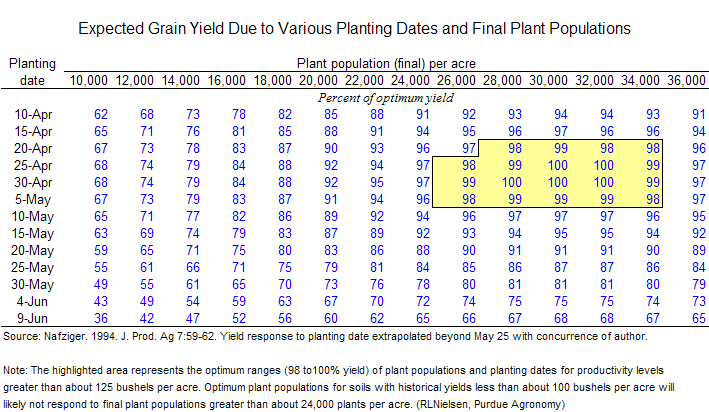

One of several requirements for uniformly quick germination in corn (Nielsen, 2007a) is uniformly adequate soil moisture in the seed zone. When seedbed soil moisture is variable (too dry vs. just right or too wet vs. just right), germination and emergence will also be variable.
Corn planted during the past couple of weeks in parts of Indiana has occurred in soils that have dried quickly in response to a string of warm, sunny days with strong winds and low humidity levels. Tilled seedbeds in particular have dried very quickly at the surface and sometimes unevenly.
Coupled with shallow compacted tillage layers that sometimes prevent planter row units from placing seed as deeply as the depth setting targets, kernels within inches of each other in the seed furrow can experience significantly different soil moisture levels. In other situations, growers may have neglected to change planter depth settings in response to the depth at which soil moisture was more uniform.
Last Friday I came across an example of fairly dramatic uneven emergence caused by variable soil moisture in a conventionally tilled field (corn following soybean) that was planted May 7. I estimated 75 to 80% of the field was comprised of “normal” emergers that were at the late V1 leaf stage (one leaf with a visible collar). Some late emergers were barely breaking through the surface, while others were yet in the process of elongating towards the soil surface.
Still other kernels showed no visible signs of germination (Nielsen, 2007b), suggesting they had not imbibed enough moisture to initiate the germination process. The non-germinated kernels were otherwise healthy with no evidence of disease or insect injury.
Given that the initial emergers were at late V1, if the non-germinated kernels eventually germinate and emerge they will likely be out-competed and not contribute to yield. Even the late emergers that were barely visible on May 18 will likely experience enough competition with their neighbors that are almost two leaves farther advanced that they will not contribute 100% to grain yield.
Seed spacing among the normal emergers suggested an initial seeding rate of 33000 seeds per acre. I estimated the percent of delayed emergers or non-germinated kernels to be no less than 20% of the stand. Yield loss due to such delayed emergence is roughly similar to that due to low population. Based on the initial seeding rate and the plant population yield response tabular data published in Purdue’s ID-179, Corn & Soybean Field Guide, the estimated yield loss in this field would thankfully only be 1 to 2 percent (33000 vs 26000). If the initial seeding rate had been closer to the lower end of the optimum range, say closer to 28000 seeds per acre, the predicted yield loss due to 20% fewer contributing plants would have somewhat higher at about 5 percent.

Carter, Paul, Emerson Nafziger, and Joe Lauer. Uneven Emergence in Corn. North Central Regional Extension Pub. No. 344. [On-Line]. Available at http://learningstore.uwex.edu/pdf%5CNCR344.pdf. (URL verified 4/23/07).
Nielsen, R.L. (Bob). 2007a. Requirements for Uniform Germination and Emergence of Corn. Corny News Network, Purdue Univ. [On-Line]. Available at http://www.kingcorn.org/news/timeless/GermEmergReq.html. (URL verified 5/20/07).
Nielsen, R.L. (Bob). 2007b. Visible Indicators of Germination in Corn. Corny News Network, Purdue Univ. [On-Line]. Available at http://www.kingcorn.org/news/timeless/GerminationGallery.html. (URL verified 5/20/07).
© 2007 , Purdue University, an equal access, equal opportunity university. This material may be available in alternative formats. If you have trouble accessing this page because of a disability, please contact RLNielsen at rnielsen@purdue.edu.